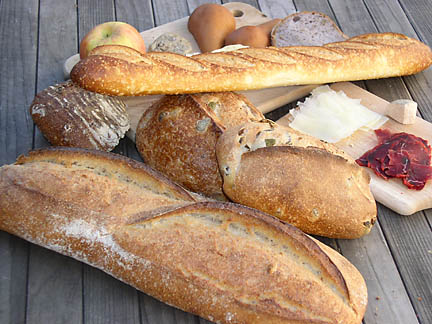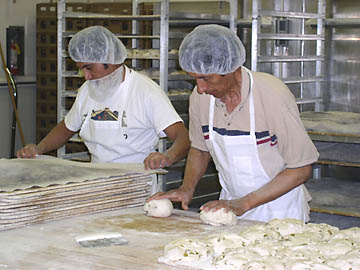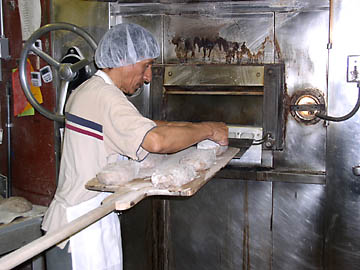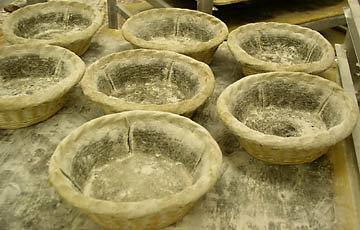
Flavor Notes by Robert Rich: Food, Wine, Restaurants & Recipes
Local Food Topics
A Sourdough Quest
by Robert Rich, February 2003, for MV Voice

I blend together some flour and water in an open jar. I cover the jar with a single layer of cheesecloth, to keep out bugs and leaves. I place this bait in the back yard on a cool damp afternoon.
In the evening, I bring the jar inside and cover it. Within a day or two its creamy contents begin foaming slightly. It smells a bit like dry white wine. I know I have captured my quarry.
Our native wild yeast has fallen from the sky and established a colony in my jar of sourdough starter. I now posess a living bit of culinary history, one of the keys to an authentic sourdough bread.
To make a loaf, I take two cups of starter, three cups of bread flour, and a teaspoon of salt. That's all. After kneading the dough, I let it rise overnight in a cloth covered basket. I bake it in a humid oven for about an hour. I replenish the starter every few days with water and flour, keeping its thin creamy texture, making sure it stays foamy and smells like clean fermentation.
The sour flavors come from a local species of lactic bacteria, which convert sugars into acids and carbon dioxide. In return, the lactobacilli protect the wild yeast by creating an inhospitable environment for competing fungi.
Sourdough's history dates to the dawn of agriculture, in Egypt and Mesopotamia. It probably arrived with Italian or French immigrants into Mexico, and then came north with the California Gold Rush. Here in San Francisco, it took on the unique flavors of our wild yeasts and bacteria.
I grew up loving this bread, with its lemony bite and leathery thick crust. I remember chewing it with caution so as not to lacerate the roof of my mouth with shards of the toasty brown corners, the most flavorful part of the loaf.
I remember noticing a change that occured in the bread from larger bakeries like Toscana, Colombo and Parisian, sometime in the mid 1970's. The sourness diminished. The crust got thinner.
Modern Changes
I later learned that the three companies had merged to become the San Francisco French Bread Company. They combined their operations into a large factory in Oakland. They changed their ovens to a high-throughput design.
In return, these ovens enabled them to bake enough bread to ship around the country, over two million loaves a week. The thinner crust proves more palatable to average American tastes; yet this bread lacks the rustic magic.
A few of the original bakers of San Francisco Sourdough still make excellent bread. The Boudin company started in 1849, and sells their bread primarily through retail bakeries around the Bay Area. I have purchased bread at the Boudin shop in Stanford Shopping Center. I like its clean tart flavor and crisp shiny crust.
In the process of trying to reacreate this bread at home, I have developed great respect for the expertise of an artisan bakery. The last two decades have seen a resurgence in small craft bakeries, and a renewed appreciation for crusty flavorful bread. Mountain View hosts one of my favorite artisan bakeries: The Acme Bread Company.
Acme
Acme Bread started in Berkeley in the early 1980's. Founder Steven Sullivan worked as a bussboy at Alice Water's famed Chez Panisse while studying at UC Berkeley in the 1970's. He later went to Europe and learned traditional bread baking techniques, then returned to Chez Panisse to bake their house bread.
In 1983, Sullivan left Chez Panisse to start Acme on the corner of Cedar and San Pablo in Berkeley, selling retail at the shop and wholesale to restaurants around the Bay. As demand increased, Acme opened a second wholesale-only bakery in 1990, branching southward into Mountain View in 1996.
While Acme doesn't claim to make traditional San Francisco Sourdough, their naturally leavened breads surpass the larger sourdough bakeries in both texture and flavor. I visited Acme to learn their secrets.
Acme's Mountain View production manager, Drew Westcott, walked me through the creation of a sourdough loaf. A single loaf takes about 35 hours from starter to oven. Forty employees work around the clock to bake 60,000 loaves a week (not all sourdough) using organic flour and old-world methods.
The starter sits unassumingly in a plastic bucket in the cooler, slowly foaming. The original wild yeast came from naturally fermenting grapes in the Napa valley. (It's no accident that healthy sourdough starter smells a bit like wine!)
A Loaf's Life
The baker starts new dough by blending a portion of this starter with more flour and water to create a sponge. Softer than dough, but thicker than starter, the sponge increases three times in volume after 12 hours in the cooler.
Acme mixes their dough in 300 pound batches, blending a 60 pound sponge with 240 pounds of flour and water. At this point they add some salt, then hand-form about 300 loaves to rise again before baking.
Acme's brick oven provides one of the secrets to thick chewy crust. With its giant rotating stone slab and internal humidifiers, it creates the perfect moist environment to caramalize the starchy sugars on the outside of the loaf.
 Because Acme hand-forms their bread, they keep their dough wetter than automated commercial bakeries. Mechanized bakeries need their dough firm so the machines can process it. The softness of hand-formed dough allows it to expand more easily in the oven, helping create a moist open texture with large shiny internal air bubbles (true sign of a classic sourdough.)
Because Acme hand-forms their bread, they keep their dough wetter than automated commercial bakeries. Mechanized bakeries need their dough firm so the machines can process it. The softness of hand-formed dough allows it to expand more easily in the oven, helping create a moist open texture with large shiny internal air bubbles (true sign of a classic sourdough.)
Baking Back Home
Ironically, Acme's production manager admitted that he doesn't bake bread at home. He told me, "We [at Acme] bake the bread that we want to eat ourselves." So why make second-best?
I still try to recreate the classic local sourdough, perhaps just for bragging rights. I try to emulate the high humidity and thermal mass of a European bread oven. A pizza stone helps stabilize the temperature, and a tray of boiling water keeps the humidity high. Indeed, great bread is alchemy, a dance of many variables.
Happily, Acme's bread comes closer to the bread of my memory than anything I can bake at home. I think it comes closer to classic "San Francisco Sourdough" than many of the breads that claim that heritage.
You can find Acme bread at Mountain View and Sunnyvale Farmers' Markets on weekends, and Costco, The Milk Pail, Andronico's, Dreager's, Whole Foods and other fine markets during the rest of the week.
